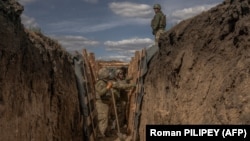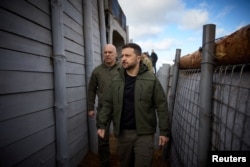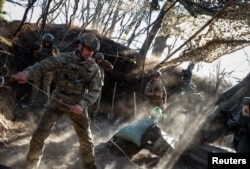Last week, Russian forces broke through Ukrainian lines in the village of Ocheretyne, building on momentum from the February capture of the industrial city of Avdiyivka about 25 kilometers to the southeast. Ukrainian commanders quickly redeployed exhausted troops from another brigade that had been fighting in the area for more than a year.
About an hour’s drive to the north, Russian troops, including elite paratrooper units, have slogged up to an important canal in Chasiv Yar, a height-of-land settlement that offers clearer lines for artillery fire targeting a critical railway supply line for Ukraine’s forces.
Hundreds of kilometers to the southwest, meanwhile, Russian motorized rifle infantry pushed into part of Robotyne, a village that Ukrainian troops recaptured during last year’s much-hyped counteroffensive that fell far short of its goals.
Ukraine’s commander in chief didn’t mince words.
“The situation at the front has worsened,” Colonel General Oleksandr Syrskiy said in a post to Telegram on April 28. Russian forces, he said, were “actively attacking along the entire front line with tactical successes in some areas.”
Beleaguered and outgunned, Ukrainian forces got a jolt of morale-boosting news last week, when U.S. lawmakers finally pushed through a $60 billion aid package dominated by weapons: anti-aircraft missiles; small-arms ammunition; 105 mm and 155 mm howitzer artillery; shells for high-precision HIMARS artillery systems, Bradley infantry fighting vehicles, and more. It came months after the last substantial deliveries were made.
But Ukraine’s battlefield position is bleak.
Its forces are badly outnumbered. Despite the government finally passing a new mobilization law aimed at getting more men into the fight, it will be weeks, if not months, before new troops can be trained, equipped, and able to make any substantive difference at the front.
And Russian commanders appear to have made a calculated decision to increase the tempo of operations, possibly aimed at high-profile victories to brag about before national Victory Day celebrations on May 9.
“In general, we are slowly losing territory,” said Ivan Stupak, an analyst with the Ukrainian Institute for the Future, a Kyiv think tank, adding that Russia is focusing its rolling advance on a narrow sector of the battlefield in the Donetsk region.
“Russia’s General Staff has deployed more manpower and equipment to Donetsk from other directions,” he told RFE/RL. “So now Russia is slowly pushing back our defense lines.”
“We have reached the point where the situation on the front line is the worst since March 2022," said Konrad Muzyka, a Polish-based defense analyst who travels regularly to Ukraine.
“The Russians' numerical superiority continues to grow, and so does the number of attacks,” he said in a post to X, formerly Twitter. “Ukraine has not endured its darkest hour. It is yet to begin.”
“Ukraine has no good options, even with the latest aid package. Many military analysts have already come to that conclusion privately but are unwilling to voice that sentiment,” wrote Eugene Rumer, a former top Russia analyst at the U.S. National Intelligence Council.
Grim Outlook
Initiative on the battlefield has shifted several times since Russia launched its mass invasion in February 2022. Ukraine thwarted Russia’s advance on the capital, Kyiv, but the invading forces seized swaths of territory in the southern Kherson and Zaporizhzhya regions and in the Donetsk, Luhansk, and Kharkiv regions in the east.
Ukraine surprised Russian troops with two localized counteroffensives in the fall of 2022, recapturing substantial amounts of land in the Kharkiv and Kherson regions.
Ukraine then spent much of the following months prepping, training, and equipping nine new armored brigades, with Western armor and assistance from NATO. Another four also received Western weaponry, and in June 2023 Kyiv launched a three-pronged counteroffensive.
It faltered, however, thwarted by extensive Russian defensive lines.
Russia’s forces, for their part, ground into higher gear, bolstered by prison inmate brigades and a major mobilization ordered by President Vladimir Putin. Russia’s sprawling industrial infrastructure retooled to supply seemingly endless streams of artillery, ammunitions, and vehicles.
In February 2024, Ukrainian troops were forced to withdraw from Avdiyikva, an industrial city that had given Ukraine a vantage point over the regional capital of Donetsk. Ukrainian President Volodymyr Zelenskiy removed the country’s popular commander in chief, General Valeriy Zaluzhniy, after Zaluzhniy gave a publicly pessimistic assessment of the war’s trajectory.
The tides have since turned further against Ukraine, in part because the flow of U.S. and other Western weaponry slowed to a trickle amid political infighting in Washington. Russia has taken advantage of the dearth of anti-aircraft defenses, using “glide bombs” -- heavy-explosive “dumb” bombs retrofitted with wings and satellite navigation -- to devastating effect.
"A difficult situation awaits us in the near future. But it will not be catastrophic, let's be clear," Kyrylo Budanov, Ukraine’s military intelligence chief, told the BBC. "There will be no Armageddon, as many are saying.... But there will be a difficult period. Mid-May, early June."
But critics say the Zelenskiy government also was slow to prioritize building its defensive lines across the 1,200-kilometer front line as it became clear Russia’s tactical strength was growing. And the government took months to push through new legislation aimed at getting more men to the front.
The lack of fresh fighters was “the most pressing issue” for Ukraine, a problem that was “exacerbated by the lack of weapons and ammunition,” said Rob Lee, a former U.S. Marine and senior fellow in the Foreign Policy Research Institute.
“The relative manpower situation is likely the most important factor that will determine the war's trajectory, particularly if Russia can sustain recruiting 20-30k a month,” he said in a post on X.
Western estimates put Russia’s casualties – killed and wounded – as high as 450,000, though a top U.S. Army general last month gave a lower figure: 315,000.
Ukraine’s casualties are sizable as well. Zelenskiy in February made his first official acknowledgment of combat losses, saying 31,000 troops had been killed in the previous two years. That number is widely seen as a major undercount.
Ukraine’s brigades are currently operating at just 40 percent of their original capacity, in terms of personnel and vehicles, according to Frontelligence Insight, a Ukrainian open-source research organization run by a Ukrainian reserve officer.
“The situation on the front line is expected to stabilize with the arrival of new ammunition, weaponry, and freshly mobilized but trained recruits,” the group said. “Nevertheless, stabilization is not anticipated immediately, as it will take time to arm, train, and prepare new recruits.”
'Putin Is In No Mood To Give Up'
Ukrainian and Western analysts say Russia has deployed around 25,000 troops, including several elite paratrooper and motorized rifle brigades, in its push to take Chasiv Yar. Taking it would allow Russian artillery to threaten the railway junction town of Kostyantynivka, to the south, and some of the supply lines Ukrainian units in the district rely on.
That in turn could put at risk the larger cities of Kramatorsk and Slovyansk, about 30 kilometers farther to the north, which still have some industrial factories, larger populations, and are more heavily fortified.
Ukrainian military and open-source analysts say Russian forces briefly crossed the canal on Chasiv Yar’s eastern side earlier this week but haven’t been able to hold it.
Ukrainian analysts also say Russia is relying on the tactic used in the capture of Bakhmut last year: World War I-style infantry wave assaults, with units comprised of poorly trained former prison inmates trailed by more elite units.
Russian forces have the upper hand, said Mick Ryan, a retired Australian Army major general, and they “will be pushing hard to make the most of their opportunity before U.S. military aid arrives in the coming weeks.”
In Ocheretye, meanwhile, unconfirmed reports say the Russian breakthrough may have been due in part to a retreat, possibly unauthorized or premature, by the 115th Separate Mechanized Brigade. Another NATO-trained and -equipped unit that had been fighting for months in the region, the 47th Mechanized Brigade, was ordered back to the village’s district, to stabilize defensive lines.
Military commanders are now reportedly investigating the unit’s command, and Ukrainian forces have also had to pull back westward from three villages on Ocheretyne’s southern edges.
"The enemy has broken through and gained a foothold in part of” Ocheretyne, Lieutenant Colonel Nazar Voloshyn, a military spokesman, said in televised comments. “All measures are being taken to knock the enemy out of there.”
“Ukraine is waging a war against an enemy that shows no inclination to stop its aggression and negotiate in earnest,” Rumer, who is now director of the Russia and Eurasia Program at the Carnegie Endowment for International Peace, wrote in his April 25 commentary. “Having bet his entire presidency on this war, Putin is in no mood to give up. Ukraine’s need for help, even with the adoption of a defensive strategy for the long run, is open-ended. Are Washington and Brussels ready for it?”
















